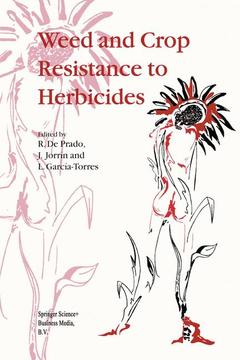Description
Weed and Crop Resistance to Herbicides, 1997
Coordinators: De Prado R., Jorrín J., García-Torres L.
Language: English
Keywords
Publication date: 10-2012
340 p. · 16x24 cm · Paperback
340 p. · 16x24 cm · Paperback
Description
/li>Contents
/li>Comment
/li>
In recent decades, repeated use of herbicides in the same field has imposed selection for resistance in species that were formerly susceptible. On the other hand, considerable research in the private and public sectors has been directed towards introducing herbicide tolerance into susceptible crop species. The evolution of herbicide resistance, understanding its mechanisms, characterisation of resistant weed biotypes, development of herbicide-tolerant crops and management of resistant weeds are described throughout the 36 chapters of this book. It has been written by leading researchers based on the contributions made at the International Symposium on Weed and Crop Resistance to Herbicides held at Córdoba, Spain. This book will be a good reference source for research scientists and advanced students.
1 Burgeoning Resistance Requires New Strategies.- I Herbicide Resistant Weeds.- 2 Herbicide-Resistant Weeds in Europe: Agricultural, Physiological and Biochemical Aspects.- 3 Herbicide Resistance in North America: History, Circumstances of Development and Current Situation.- 4 Herbicide Resistance Outside North America and Europe: Causes and Significance.- II Herbicide Resistance Mechanisms.- 5 Resistance to PS II Inhibitor Herbicides.- 6 Target-Site Based Resistance to ACCase Inhibitors.- 7 Perturbation of the Transmembrane Proton Gradient and Resistance to AOPP Herbicides.- 8 Target-Site Resistance for Acetolactate Synthase Inhibitor Herbicides.- 9 Mechanism of Resistance to Dinitroaline Herbicides.- 10 Cytochrome P450 Endowed Herbicide Metabolism.- 11 Glutathione Transferases and Herbicide Metabolism and Selectivity.- 12 Mechanisms of Herbicide Multiple Resistance in Lolium rigidum.- 13 Is there a Multiple Pesticide Metabolizing Cytochrome P450 in Maize?.- 14 D-1 Protein Turnover and Sensitivity of Higher Plants to Photosystem II-Directed Herbicides.- 15 Penetration, Translocation and Metabolism of Pyridate in Chickpea.- 16 Distribution Studies of Propanil Resistance in a Barnyardgrass Biotype and Elucidation of its Resistance Mechanism.- 17 Mechanisms of Resistance to Protoporphyrinogen Oxidase-Inhibiting Herbicides.- 18 Metabolism of Chlorotoluron in Resistant and Susceptible Alopecurus myosuroides Huds. Biotypes. A Study Using Plant Cell Suspensions.- III Genetics and Biology of Herbicide Resistant Weeds.- 19 Molecular Ecology: its Role in Studying Herbicide Resistance.- 20 Genetics of Herbicide Resistance within Weeds. Factors of Evolution, Inheritance and Fitness.- 21 Effects of Mutation for ALS-Inhibitor Resistance on ALS Activity in Resistant and Susceptible Near-Isonuclear Lactuca Lines.- 22 A Biochemical, Physiological and Molecular Characterization of Herbicide Resistance in Echinochloa spp..- 23 The Potential for the Evolution of Herbicide Resistance:Selection, Characterisation and Polygenic Inheritance of Resistance to Chlorsulfuron in Perennial Ryegrass.- IV Biotechnological Approaches to Develop Herbicide Resistance in Crops. Problems and Possibilities.- 24 Herbicide Resistant Crops Generated by Biotechnology.- 25 Manipulation of Crop Tolerance to Herbicides with Safeners.- 26 Gene Flow between Crops and Weeds: Risk for New Herbicide Resistant Weeds?.- 27 Technological, Ecological and Social Aspects of Herbicide Resistant Crops.- 28 Unexpected Fallout from Herbicide Resistance; Resistance to Drought, Oxidants and some Fungal Stresses.- 29 Synergized Mycoherbicides for Resistance Management.- 30 Parasitic Weed Control Using Transgenic Herbicide-Resistant Crops.- V Managing or Avoiding Herbicide Resistance: Integrated Mechanical, Chemical and Biological Methods for Weed Control.- 31 Strategies for the Prevention and Control of Herbicide Resistance in Annual Grass Weeds.- 32 Risks and Benefits of Weed Management Technologies.- 33 Role of the Herbicide Resistance Action Committee in Weed Resistance Management.- 34 Prevention and Control of Herbicide Resistant Weeds in Australia.- Chapter35 From Research to Practise: Staying ahead of the Problem.- Conclusion.- 36 Will Herbicide Resistance Ultimately Benefit Agriculture?.
In recent decades, repeated use of herbicides in the same field has imposed selection for resistance in species that were formerly susceptible. On the other hand, considerable research in the private and public sectors has been directed towards introducing herbicide tolerance into susceptible crop species. The evolution of herbicide resistance, understanding its mechanisms, characterisation of resistant weed biotypes, development of herbicide-tolerant crops and management of resistant weeds are described throughout the 36 chapters of this book. It has been written by leading researchers based on the contributions made at the International Symposium on Weed and Crop Resistance to Herbicides held at Cordoba, Spain. This book will be a good reference source for research scientists and advance
© 2024 LAVOISIER S.A.S.




